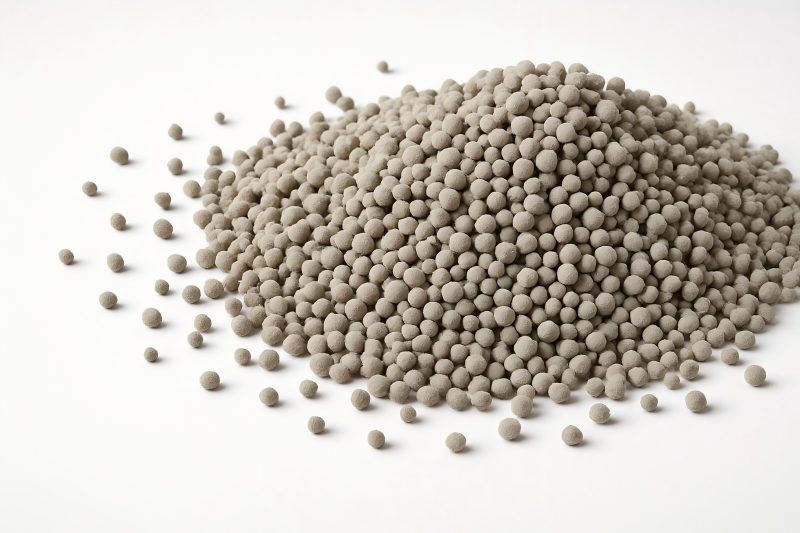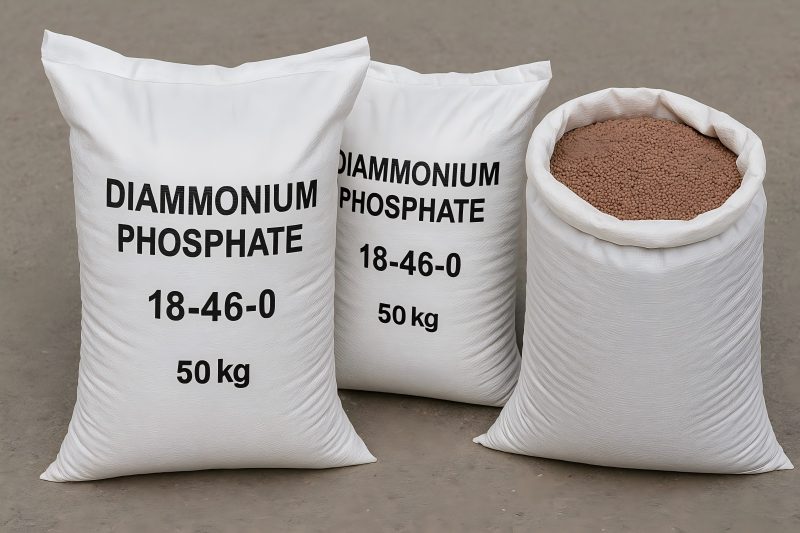Diammonium phosphate (DAP) serves as a high-analysis source of both nitrogen (N) and phosphorus (P) and is extensively applied across many cropping systems and soil types. Its popularity stems from its favourable nutrient content, ease of handling, good storage/transport properties, and versatility of application.
This guide provides a thorough overview of DAP, covering its chemical and physical properties, production and manufacturing methods, typical forms and grades, major applications (agricultural and industrial), handling and storage considerations, environmental and safety aspects, cost drivers and pricing, procurement and quality tips, and finally future trends.
Properties

Chemical formula and composition
DAP has the chemical formula (NH₄)₂HPO₄.
The typical nutrient grade for fertilizer-grade DAP is 18-46-0 (18% N, 46% P₂O₅) though some sources cite slight variation (e.g., 18-46 or 21-46) depending on market or region.
In physical/chemical terms:
Molecular mass ≈ 132.06 g/mol.
The product is highly water-soluble. For example, solubility is reported as ~588 g/L at 20 °C.
The aqueous solution of DAP tends to have a pH around 7.5-8.0 when dissolved.
Because of the ammonium ions, some release of ammonia under high temperature or high pH conditions may occur.
Physical forms, granules and handling
Fertilizer-grade DAP is typically produced and sold as free-flowing granules, often of specific granule size (e.g., 2-4 mm, or other granule size number SGN) in order to have predictable spreading behaviour, good storage and transport characteristics, low dust, and uniform nutrient content.
Physically, characteristics such as bulk density, angle of repose, uniformity index, moisture content, and critical relative humidity (CRH) are relevant for handling and storage. For example, DAP has a relatively low CRH (<70%) which means it is more prone to absorbing moisture from humid air compared with some other fertilizers such as MAP (Monoammonium Phosphate).
Nutrient behaviour in soil
When applied, DAP dissolves and provides both ammonium-N (NH₄⁺) which is a plant-available nitrogen source, and phosphate (HPO₄²⁻ / H₂PO₄⁻ depending on pH) which is the plant-available P form.
One notable behaviour: the immediate dissolution of DAP can temporarily raise the local pH around the granule (because of the ammonium and hydrogen phosphate chemistry) which may affect seedling roots if the granule is placed too close to seeds. Over time, nitrification of the ammonium (to nitrate) will tend to reduce pH in that micro-zone.
Production Methods
Raw materials and reaction
The primary raw materials for DAP manufacture are ammonia (NH₃) and phosphoric acid (H₃PO₄), which itself is derived from phosphate rock (via acidulation) together with sulfuric acid or other agents in typical fertilizer industry pathways.
In simplified form the chemical reaction may be presented as:
2NH3+H3PO4→(NH4)2HPO4
Process overview
Phosphate rock is treated with acid (often sulfuric acid or via other processes) to yield phosphoric acid.
Ammonia is added to phosphoric acid under controlled conditions to form the ammonium phosphate salt.
The slurry is cooled, granulated and screened into desired granule sizes, dried, cooled again and coated (if required) to reduce caking/hygroscopy.
Quality control steps including moisture, granule hardness, size distribution, nutrient analysis (N, P₂O₅) are performed. For example, a data sheet shows DAP typical composition: 18% N, 46% P₂O₅, ground moisture ~2.2%.
Key inputs and cost-drivers
Producing one ton of DAP typically requires 1.5–2 tons phosphate rock, about 0.4 tons sulfur, and roughly 0.2 tons ammonia.
Thus fluctuations in the prices or availability of phosphate rock, sulfur, ammonia (or energy) can affect DAP cost/availability.
Forms, Grades & Specification
Typical grades
The standard commercial grade is designated as “18-46-0”, meaning 18% total nitrogen (N), 46% P₂O₅ (which translates to ~20% elemental P) and 0% K₂O (potassium oxide) unless blended with other nutrients.
Some variation exists depending on local markets, but essentially DAP is a high-analysis, high-P fertilizer product.
Physical specifications
For instance, one technical data sheet lists: bulk density ~930 kg/m³ (~58 lb/ft³), granules size ≥ 90% in 2-4 mm fraction, uniformity index 55, ground moisture ~2.2%.
Critical Relative Humidity (CRH) at 30 °C for DAP is < 70%.
Packaging and storage
DAP is typically bagged (e.g., 50 kg bags) or can be supplied in bulk (silo, super sacks) for large-scale agricultural use. Because it is hygroscopic and can absorb moisture/humidity (leading to caking) special attention must be paid in storage, especially in humid climates.
Applications
Agricultural applications
DAP’s primary use is as a fertilizer—providing both nitrogen and phosphorus to crops.
Basal application
DAP is often applied at planting time (basal dose) because phosphorus is relatively immobile in the soil and early root development benefits from a strong supply of P; the ammonium N portion also provides quick N.
Crop types and timing
It is suitable for a wide range of crops—cereals, oilseeds, legumes, vegetables and tree crops. For example, one regional article notes use for vegetables (pepper, cucumber, lettuce), fruit/tropical trees (oil palm, mango), and pulses/legumes (soybean, cowpea) as a starter fertilizer.
Use in different soils
DAP is useful in neutral to acidic soils; however, caution is required in alkaline soils (soil pH > 7) because ammonium might be lost via volatilization. For example, a fact sheet states that DAP may be more prone to N loss on alkaline soils when broadcast.
Specialty uses
In some forestry-site trials, DAP was used in microsite application around planted seedlings to enhance early growth of pines.
Industrial/non-agricultural applications
While the main market is agriculture, DAP also has several non-fertilizer applications:
- Fire retardant: DAP can act as a fire retardant, reducing combustion temperature and helping form char.
- Use in food industry: DAP is sometimes used as a yeast nutrient in wine-making or brewing.
- Use in industry: It can serve as a flux in metal finishing or soldering and as a chemical intermediate in other processes.

Advantages & Limitations
Key advantages
High nutrient content for phosphorus: Among synthetic P‐fertilizers, DAP offers one of the higher P₂O₅ percentages (≈ 46%).
- Dual nutrient supply: Supplies nitrogen (in ammonium form) and phosphorus together, which simplifies fertiliser logistics and handling in many cropping systems.
- Good physical properties: When properly manufactured, DAP granules are free-flowing, dust-reduced, easy to store and spread uniformly.
- Widely available and traded globally: Its broad manufacture base makes it reasonably accessible in many global markets.
Limitations & considerations
- Placement hazard: Because ammonium release and localized pH rise can cause seedling damage if DAP is placed too close to seeds, careful placement is required.
- Hygroscopic risk and caking: The lower CRH (<70%) means DAP tends to absorb moisture more readily compared to some other fertilisers, increasing risk of caking or storage issues in humid conditions.
- Volatilization risk on high pH soils: On alkaline soils, ammonium nitrogen may convert to ammonia gas and be lost, reducing nitrogen use‐efficiency.
- Soil pH effect: While initially DAP may raise local pH around granule, over time nitrification tends to acidify the soil micro-environment—so regular soil‐pH monitoring is advisable.
Safety, Handling & Storage
Personal protective equipment (PPE) & handling
While DAP is not highly hazardous compared to some industrial chemicals, standard chemical handling protocols apply:
- Use gloves, protective clothing and eye/face protection when handling powders or dusts.
- Avoid dust inhalation and prevent eye or skin contact.
- Ensure good ventilation in storage/handling areas.
Storage conditions
- Store in a cool, dry, well-ventilated place, away from humidity and extreme temperatures.
- Use materials resistant to the chemical (e.g., polyethylene bags, steel silos with appropriate linings).
- Keep packaging sealed until use, prevent ingress of moisture—once moisture is absorbed the granules may begin to dissolve and recrystallize, leading to caking or granule break-down.
- In humid climates, storage life may be shortened; storage outside under cover is not recommended for long term.
Transportation and packaging
- DAP is typically transported in bulk trucks (covered) or bagged shipments (50 kg bags).
- Labeling should include nutrient grade (18-46-0), hazard information (if any) regarding dust/anhydrous ammonia release risk under certain conditions.
- When shipped internationally, ensure the handling documentation includes correct storage advice to prevent moisture pickup.
Environmental Impacts & Sustainability
While DAP is a key tool in global agriculture enabling high crop yields, its production, handling and use have environmental implications which must be managed.
Production impacts
- Mining of phosphate rock and its acidulation to phosphoric acid generate waste solids (phosphogypsum, fluorides, heavy metal residues) and require significant energy.
- Ammonia production (for NH₃ feedstock) is energy‐intensive and CO₂-emitting (unless green ammonia technologies are used).
- Transportation and packaging contribute further emissions.
Field use impacts
Over‐application or broadcast in inappropriate conditions can lead to nutrient runoff or leaching (especially phosphorus) into water bodies → risk of eutrophication.
On alkaline soils, ammonium may volatilize as ammonia, which is lost to the atmosphere (inefficient use and potential air quality issue).
Frequent use of high-analysis P fertilizers without balanced soil management may lead to P fixation in soils, reduced P use efficiency, and long-term soil acidification around granules.
Sustainability practices
Soil testing and precision agronomy: Use DAP only in correct rates, times and placements to maximise plant uptake and minimise losses.
Blending with other nutrients or using coated/controlled-release forms may reduce losses.
- Efficient logistics: Bulk shipments, minimal packaging waste, optimise supply chain to reduce transport emissions.
- Recycling or reuse of by-products in the manufacturing process (e.g., utilizing phosphogypsum waste, closed loop systems).
Consideration of alternative fertilizers or integrated nutrient management (e.g., combining mineral fertilizers with organic matter, cover cropping) to reduce dependence on single high-analysis products.
Cost Drivers & Pricing
Key inputs and market drivers
As noted earlier, major cost drivers in DAP production include: phosphate rock price (and associated acidulation cost including sulfur), ammonia (NH₃) feedstock cost, energy cost (electricity/fuel for production and granulation), transport/ logistics, packaging, storage, and local/regional duties or taxes.
Variations in any of these affect DAP price and availability. Additionally, demand in agriculture (especially in major markets such as India, China, Brazil) and trade flows (exports/imports) strongly influence spot prices and long‐term contracts.
Farmer/consumer cost considerations
For an agricultural buyer, it’s useful to compare nutrient cost per unit of N or P. For example, one extension document shows how to calculate cost per pound of P₂O₅ using the nutrient content and product price.
Storage and handling costs also matter: since DAP is somewhat hygroscopic and may cake, storage losses or repackaging costs may increase effective cost.
Procurement tips
- When purchasing, compare nutrient-value (e.g., cost per pound of P₂O₅ or N) rather than simply cost per ton of product.
- Check storage/transport conditions: product that has absorbed moisture may have reduced effective nutrient value or physical quality.
- Consider the grade and granule size: good granulation affects spreading uniformity and crop uptake.
- Contracting early or using pooled buy may reduce price risk in volatile markets.
- Ensure supplier provides SDS/MSDS and quality certificates (N, P₂O₅, moisture, granule size) to verify conformity.
Quality & Specification Guidelines
As a manufacturer or supplier of DAP, maintaining high standards is critical. Some key specification parameters include:
- Nutrient content: Ensure minimum guarantee of 18% N and 46% P₂O₅ (or local grade equivalent).
- Moisture: Low moisture (~2% typical) to avoid granule degradation, caking or handling issues.
- Granule size distribution: A high proportion (e.g., ≥ 90%) in desired size range (e.g., 2-4 mm) ensures uniform spreading.
- Bulk density and physical integrity: Good free-flowing behaviour, minimal fines/dust, low breakage.
- Storage stability/hygroscopic behaviour: CRH <70% means product is more hygroscopic—so anti-caking agents or coatings may be applied.
- Solubility/water stability: Ensuring rapid solubility in water so nutrients are plant‐available.
- Contact toxicity/seeding safety: Because of potential seedling ammonium/alkaline pH effect, product should have controlled impurity levels and instructions for safe placement.
Trends & Future Outlook
Innovation in fertilizer technology
- Enhanced‐efficiency fertilizers: Coated or controlled‐release DAP or ammonium-phosphate products are being developed to reduce losses (volatilization, fixation) and allow tailored nutrient release.
- Precision agriculture: Use of variable-rate application (GPS guided), soil/plant sensors and modelling to optimise DAP placement and minimize environmental impact.
- Alternative feedstocks: Some research is exploring lower-quality phosphate rock or recycled phosphorus sources to produce DAP in more sustainable ways.
- Green ammonia: As ammonia production moves toward low‐carbon routes (e.g., hydrogen from renewables), the cost/footprint of the N component in DAP may improve.
Market dynamics
Global demand for P-fertilizer remains strong, particularly in emerging markets with increasing food demand and limited arable land. DAP continues to be a backbone for P supply.
- Trade and geopolitics: Phosphate rock supply is concentrated in certain countries; export restrictions, logistics bottlenecks or trade tariffs can quickly affect DAP availability and price.
- Environmental regulations: Stricter regulations on nutrient runoff, eutrophication, mining waste may raise costs or limit certain manufacturing practices, pushing industry toward more sustainable products.
Outlook for manufacturers & suppliers
- Manufacturers should invest in storage/handling improvements (anti-caking, coating, humidity control) to maintain product quality in humid climates.
- Suppliers should offer agronomic value-services (soil testing, placement advice) alongside product supply to differentiate in competitive markets.
- Sustainability credentials may become a competitive advantage: e.g., “low-carbon DAP”, “mined responsibly”, “reduced-loss formulation”.
- Diversification of application methods (e.g., fertigation, foliar feeding, specialty crops) may open new segments for DAP or bespoke ammonium-phosphates.
In summary, diammonium phosphate (DAP) represents a critical component of modern crop nutrition. Its high phosphorus content and dual nutrient provision of nitrogen make it a favoured choice in many agricultural systems globally. For manufacturers and suppliers, understanding its chemical and physical properties, production route, storage and handling characteristics, application methods, and market dynamics is essential to deliver value and maintain competitiveness.
At the same time, environmental, safety and sustainability considerations are increasingly important: efficient use, careful placement, minimal losses and responsible sourcing are key imperatives. As the fertilizer industry evolves—driven by sustainability goals, precision agriculture and shifting raw material economics—DAP will likely continue to play a major role, albeit with refinements in formulation, placement and supply chain practice.
For buyers and users, performing soil testing, selecting appropriate rate/placement, and partnering with a trusted supplier who guarantees quality and supports proper agronomic advice will maximize return on investment and minimize risk.
